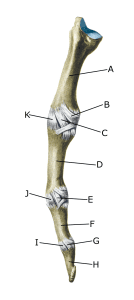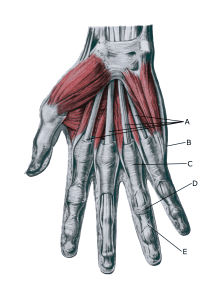Anatomy
The five fingers of the hand are made up of 14 small, tubular finger bones (phalanges). The phalanges are held together by various ligaments. The joint capsule around the finger joints is reinforced by three ligaments (two lateral ligaments and a ligament below the joint (volar). The ligament below the finger joints is reinforced by a small cartilage plate (fibrocartilago) that stabilises the  joints of the fingers (PIP joints).
joints of the fingers (PIP joints).
Finger:
A. Os metacarpale
B. Lig. palmare
C. Lig. collaterale
D. Phalanx proximalis
E. Phalanx media
F. Phalanx distalis
G. Capsula articularis

Right hollow hand:
A. M. flexor digitorum superficialis
B. Cutis
C. Vagina fibrosa digitorum manus
D. Pars anularis vaginae fibrosae
E. Pars cruciformis vaginae fibrosae
Cause of the problem
Blows, twists or overstretching can rupture the ligaments and cartilage discs (fibrocartilago) that surround the finger joints. In some cases, there may be a tearing of a piece of bone where the ligaments attach to the side of the bone.
Symptoms
With ligament injuries, there will typically be swelling of the joint and tenderness on the side of the joint with worsening if the joint is ‘twisted’ from side to side. If the cartilage plate (laesio fibrocartilaginis volaris) under the joint is damaged, the pain will be localised to the underside of the joint, worsening with passive overstretching and maximum bending of the joint.
Examination
Diagnosis is usually made by clinical examination alone, where the stability of the ligaments can be tested. The best results are achieved if the diagnosis is made and treatment is started immediately after the injury.
If there is any doubt about the diagnosis, an ultrasound scan can be performed. Possibly an X-ray if a fracture of the finger is suspected. X-rays (and ultrasound scans) can sometimes show the tearing of a small piece of bone at the ligament attachment on the side of the finger.
Treatment
Reduction from pain-inducing activity. The vast majority of ligament ruptures can be treated conservatively, possibly with a splint or tape. For ligament ruptures with obvious looseness, surgery may be considered, especially in the case of thumb ruptures of the medial collateral ligaments of the thumb.
Damage to the cartilage plate (fibrocartilago) under the finger joint is usually treated by splinting the finger for a few weeks. Some complex (combination) injuries may require surgical treatment.
Rehabilitation
Usually, training and sporting activities can be continued unchanged with a suitable bandage. It is recommended that the injured finger is taped together with the neighbouring finger for a few months when resuming normal sports activities, especially handball, volleyball, basketball etc.
If surgery has been required, there may be specific precautions that are informed by the surgeon.
Bandage
Taping the injured finger together with the neighbouring finger will often stabilise the joint, see taping.
Complications
In the vast majority of cases, the ligaments heal without complications. However, in some cases, especially after injury to the cartilage plate underneath the joint, long-term discomfort can occur up to a year after the injury.
